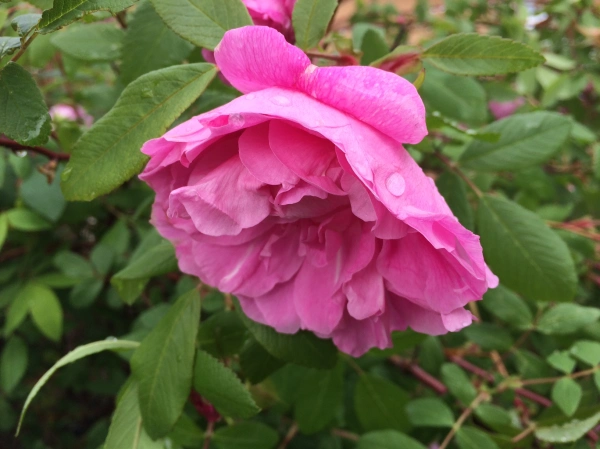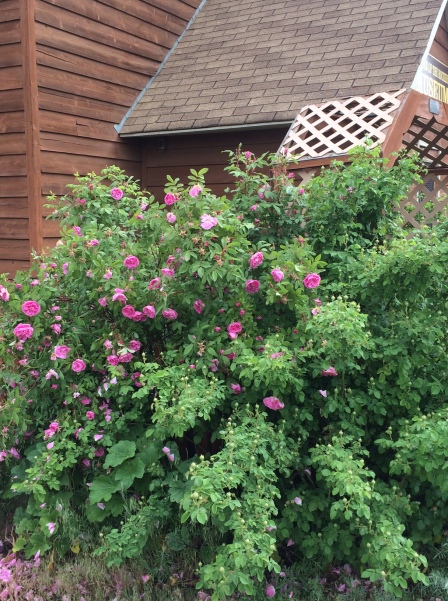HARDY FLOWERING SHRUBS FOR MONTANA
SOME HEIRLOOM AND NEWER HARDY SHRUBS
I wish I had more pictures to illustrate this article; but I include a few of hardy shrub roses. All the shrubs described here grow well with organic gardening practices.
Flowering shrubs brighten our home gardens. They bring beauty and fragrance while providing cover and nesting places for birds. Listed below are a few shrubs well-adapted to the cold climates of Montana, Idaho, Wyoming and Colorado. Some of the plants described will grow in the northern prairie states.
Lilacs, especially the common and French lilac hybrids (Syringa vulgaris) appreciate our climate. The flowers of common lilacs are soft, pale purple. The bushes are tall, up to 20 feet when aged. Once established, lilacs can really take care of themselves, tolerating cold winters and dry summers without care. They flower more heavily if old bloom spikes are trimmed off, and plants are fertilized in the fall with bone meal, wood ashes and a light dusting of compost or manure. Lilacs make a great hedge and deer tend to leave them alone, as the leaves have a bitter taste.
Shrub roses are terrific, hardy plants for our area. The relatively new Canadian hybrid shrub roses are excellent. Two Canadian-bred climbers, growing 10 to 12 feet, are ‘Henry Kelsey; with double red flowers; and ‘Champlain’ with bright pink flowers. Both of these will not winter kill here and are hardy to USDA zone 3, so can be grown all over Montana. Another repeat-blooming Canadian rose, growing 3 to 4 feet tall is ‘John Davis’, with double red blooms. It makes a good bedding rose and is hardy to zone 4. ‘John Davis’ would not require protection in Western Montana.
Some heirloom roses that do well in cold climates are described here: ‘Suzanne’ a hardy rose from the 1930s, shown in the first two pictures above. ‘Suzanne’ blooms in late spring with a wonderful display of color. The plant is hardy to USDA zone 2. Two other old roses frequently seen in the dry Western States are ‘Harison’s Yellow’ from the 1830s and “Austrian Copper’ (Rosa foetida bicolor). Both are winter hardy to zone 4, bloom in late spring and are drought tolerant once established. One occasionally sees other related roses, such as white Pimpinellifolia roses. The third picture above was taken in a roadside garden of a farm house on the foothills of the Mission Mountains in Western Montana, USDA zone 4. The plant was covered with flowers in late May-early June. Pimpinellifolia roses are very hardy, their ancestors originated in northern Scotland. If you grow any of these once-blooming, drought tolerant, hardy shrub roses remember to place them in full sun and water well until established.
Our beautiful, ubiquitous wild rose, (Rosa woodsii) is shown in the last picture. It makes a broad, suckering shrub useful for the edges of your garden. It is drought and cold tolerant, but blooms only once a year, in mid spring. Plants are sun-loving, but tolerate shade well, where they will grow taller. Their foliage is healthy and the fragrance of the flowers is delightful. The only other rose with a similar fragrance is the true ‘American Beauty’ a very rare hybrid perpetual rose. I grew it once, and when cuttings were taken they failed to strike. ‘American Beauty’ has infrastipular prickles, little thorns below the leave stipules, just like Rosa woodsii, which makes me surmise that ‘American Beauty’ may be descended in part from Rosa woodsii. Keep in mind that roses often sold as ‘American Beauty’ are usually ‘Ulrich Brunner Fils’, a similar hybrid perpetual with no infrastipular prickles.
Silver Buffalo Berry (Sheperdia argentea) is a tough, drought tolerant native shrub growing 6 to 12 feet tall and wide. It can spread by suckers, so give it room. This sun-loving shrub is a good food plant for wildlife, providing red berries and protective cover for birds. Buffalo Berry makes a sturdy hedge or windbreak requiring no care once established. It is also very winter hardy, to USDA zone 2.
The shrubby Potentillas (Potentilla species) are drought tolerant, colorful shrubs frequently seen in public landscapes. They are hardy native shrubs, growing 3 to 4 feet tall, available in several colors. Potentillas tolerate drought and heat, but best of all, bloom all summer. Full sun is best for them. It is easy to shape your plants in the fall, trimming off the oldest stems.
Two native shrubs that prefer moisture and part shade are mock orange (Philadelphus lewisii) and Rocky Mountain maple (Acer glabrum). Mock orange grows 8 to10 feet tall and produces deliciously scented flowers in late spring. Rocky Mountain maple is a beautiful, small maple growing 6 to 10 feet tall, with dark red wood and golden fall color. Both of these plants could be placed on the north side of a building where their roots would be in shade and tops in sun. Be sure to leave 3 to 4 feet or more between the shrubs and the building.




